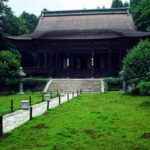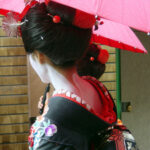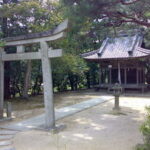Today in Japan, many couples have to decide between having a traditional Japanese wedding or a more modern Western wedding. Both weddings are rich in culture and still have a distinct flair of Japanese tradition instilled in them.
The traditional Japanese wedding takes place in a Shinto shrine, due to the fact that Japan’s largest religion is Shinto. These traditional wedding ceremonies are small and usually private, with only family and close friends present.1
In these traditional wedding ceremonies, the bride wears a white wedding kimono dress called shiro-maku, meaning white and pure. Her hair is styled in a style called bunkin-takashimada and decorated with decorations called kanzashi ornaments. She also wears a white wedding hood called a tsuno kakushi.1 In some weddings, she is painted white from head to foot to signify her purity.2
The grooms in these traditional wedding traditions wear a montsuki kimono. He also wears a short overcoat called a haori, which is decorated in the family crest, and pleated pants called hakama.1
The traditional wedding ceremony is performed by a Shinto priest. The families of the couple face each other during this ceremony, unlike in Western weddings where the couples face each other.2 The Shinto priest begins by purifying the couple and then performs the vows. This is called by the tradition called san san kudo, in which the couples drink nine cups of sake, symbolizing the unification of the couple. Families and guests also drink sake to represent the bonding of the two families. Then the ceremony closes with symbolics offerings of small tree twigs called sakaki to the Kami.1 During this ceremony, the music is performed by flutes by musicians called gag a ku. After the ceremony, the father of each family introduces their family member.1
After the traditional wedding ceremony is performed, the wedding party and the guests engage in celebration. They perform skits, karaoke, and offer the couple money called goshugi in a festive envelope. Traditional Japanese food is served at these receptions.1 In most cases, the bride changes clothing twice: first into a red kimono and again into a western-styled gown. This changing of her clothing signifies the bride’s readiness to return to daily life. Female guests usually wear traditional kimono and men wear Western style suits.3
Western style weddings also take place in Japan. More couples are engaging in this type of wedding, mostly because of the high cost of the traditional Shinto wedding.3 Although these weddings are adopted from the Western world, they still contain traditional Japanese wedding traditions.
The Western style weddings in Japan take place in reception halls. Most reception halls in Japan have miniature Japanese Shinto shrines inside, so the couples can still honor their religious beliefs and vow their marriage to the Japanese God called Kami.3
The bride wears a traditional Western style wedding dress. Many brides rent their gowns at wedding boutiques to cut costs. The men wear traditional Western style tuxedos. The Western ceremony is the same as in the traditional Japanese weddings, except for the location and clothing.3
After the wedding ceremony, the bride and groom are introduced as husband and wife at the reception. The reception food in these Western style weddings differ from those of traditional Japanese weddings in that the food can be French, Chinese, or Japanese cuisine instead of just traditional Japanese food. The wedding also includes the Western traditions of the cutting of the cake, dances, speeches, bouquet tossing, exchanging rings, and honeymoons.3 Typically, no skits are performed, unlike at the traditional Japanese weddings. The bride will also perform the changing of the clothes seen in the traditional Japanese wedding. However, instead of a red kimono and then a Western style gown, she will change into a wedding kimono and then to a party dress.3
Although the Western styled Japanese wedding still retains Japanese culture in some way, if couples want to truly marry with their cultural traditions, then the traditional Japanese wedding is the best way to do so. However, for many couples this is a problem because of the high costs of a traditional wedding, which includes the expensive renting of the Shinto temple, the kimono and decorations, etc. Thus, more couples today are choosing the Western style wedding over the traditional wedding as a way to save costs. There is also a trend developing in which the number of couples marrying abroad is increasing. By marrying abroad, the couple can combine the costs of the wedding along with the honeymoon, thus saving money.3 If the Japanese society wishes to maintain their culture’s wedding traditions, then they must find a way to reduce the costs of a traditional Japanese wedding.
1Japanese Weddings, Wedding Traditions, Customs, and Ceremony. February 23, 2000 online. Available: http://www.Japaneseweddingfavors.com/Shinto_wedding.htm
2 World Web Traditions Online. Weddings Traditions in Asia: Japanese Wedding Traditions. October 8, 2000 online. Available: http://www.world-wedding-Traditions.net/asia/japan_wedding_traditions.htm
3Japanese Weddings, Favors, and Wedding Gifts Today. February 23, 2000 online. Available: http://www.japaneseweddingfavors.com/Japanese_wedding.htm



